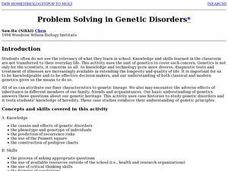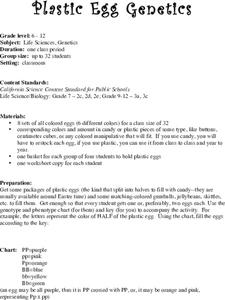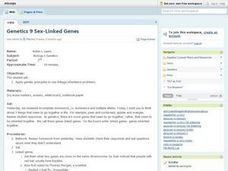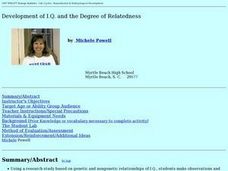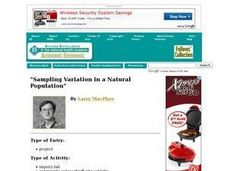Curated OER
Problem Solving In Genetic Disorders
Students explore the causes and effects of genetic disorders. They examine the phenotype and genotype of individuals and predict the recurrenence risks. Students generate a Punnett square and construct pedigree charts.
Curated OER
Gene Puzzles
Students come to understand that in sexually reproducing organisms, such as humans, typically half of the genes come from each parent.
Students examine a fictional pedigree and determine which gene is responsible for a given trait. The...
Curated OER
The Spanish Omelet
Students use analogies to show the relationships among cell, nucleus, genes, chromosome, ribosome, replication, mitosis, transcription, translation, DNA, RNA, amino acids and proteins, genotype, phenotype, and genetics vs. environmental...
Curated OER
Yeast: A Dihybrid Cross
Students create a yeast dihybrid cross and follow two forms of each of two traits: red growth versus cream color, and tryptophan-dependent versus tryptophan-independent. They complete diagrams to represent the alleles, predict the...
Curated OER
Parental Genes
Eighth graders explore how different organisms pass their traits to their offspring. In this life science lesson plan, 8th graders differentiate recessive and dominant alleles. They predict the phenotype based on the genotype of an...
Curated OER
Genetics of Parenthood
Learners participate in an activity where they flip coins to determine which allele they pass on to the F1 generation and draw the resulting child's face. They identify several inheritance patterns including dominant, recessive,...
Curated OER
Genetics
In this activity, students will answer 4 fill in the blank statements about Mendelian inheritance and meiosis. Then students will use Punnett squares to answer three short answer questions. Students will match 8 genetics vocabulary words...
Curated OER
Family Pedigrees
Students work as a class to first construct a pedigree of a popular singer, showcasing the singing gene being passed down through the generations. Students then make their own family pedigree and follow two traits through their family...
Curated OER
Genetics Mendelian
Students explore genetic terms, the Law of Dominance and the contributions of Gregor Mendel. After discussing Mendel's lab and his pea plants students observe examples of a phenotype chart. Afterward, they conduct their own lab to...
Curated OER
Plastic Egg Genetics
Students are introduced to the concepts of genetic dominance, recessiveness, related terms, Punnett Squares, etc.
Curated OER
Sex-Linked Genes
High schoolers review the concepts of incomplete dominance, co-dominance and multiple alleles. As a class, they are introduced to the concept of sex-linked genes and how they are passed to offspring. To end the lesson, they examine...
Curated OER
Population Study and Applications Using PTC Paper
Students study human population traits. In this science lesson plan, students gain an understanding of the terms dominant, recessive, haploid (monoploid), diploid, genotype, phenotype, scientific sampling, and scientific modeling as they...
Curated OER
Wearing My Genes: Basic Principles of Heredity
Students explore heredity. In this science lesson plan, students examine what heredity is, distinguish the difference between the dominant and recessive genes, explain the difference between phenotype and genotype, and predict the...
Curated OER
Modeling a Gene Pool
In this genetic activity, students examine how gene frequency changes in a population of organisms. After completing 5 pre-lab questions, they work in pairs to collect data and answer 5 additional post-lab questions.
Curated OER
Apoptosis: Programmed Cell Death During Development
Students model the plasticity of neural pathways for memory in the brain. They simulate the cell activity according to dots on cards that they are given. They complete various simulations of different cell combinations.
Curated OER
Heredity (Mendelian Genetics)
Students observe and record observations of whether a person is a taster or nontaster. They test selected individuals from their families and peer groups and chart all findings to determine which trait (e.g. taster or non-taster) is...
Curated OER
Blood Business
Students identify the different kinds of blood. In this biology instructional activity, students investigate the antigens, agglutinins and Rh factor using their own blood. They use Punnett squares to predict blood type of offspring.
Curated OER
Designer Babies
Students differentiate phenotypes and genotypes. In this genetics lesson, students complete the punnett square. They design their own baby by choosing the phenotype they want.
Curated OER
The Genetics of Parenthood
Students explore the field of genetics. Through a graphing activity, students assess four common traits. They complete a Meiosis I and II charts which represent possible gametes for an individual. Students discuss phenotype and...
Curated OER
Inheritance Word Search Puzzle
In this literacy worksheet, students find the words that are related to the concept that is the theme of the word search puzzle.
Curated OER
Development of I.Q. and the Degree of Relatedness
Studnets, in groups, analyze data regarding genetic and nongenetic relationships of I.Q. They make observations and discuss correlations from a diagram. Cooperative learning teams discuss a given set of questions and present information...
Curated OER
"Chips" Off the Old Block?
Students study using analogies between common items or occurrences and science concepts. They use the analogy of cookie recipes to that of the DNA "recipes" for living things to help us explain more about mutations.
Curated OER
Sampling Variation in a Natural Population
Young scholars examine the phenotypic variation within a natural population of a single species. They collect data on the species and analyze the data using statistical/spreadsheet software. Students interpret their results and present...
Curated OER
The Electrophoresis of Human Hemoglobin
Students analyze different types of hemoglobin. They use the technique of agarose gel electrophoresis to separate human hemoglobin molecules according to their electrical charge, size, and/or shape. Students relate the migration of...
